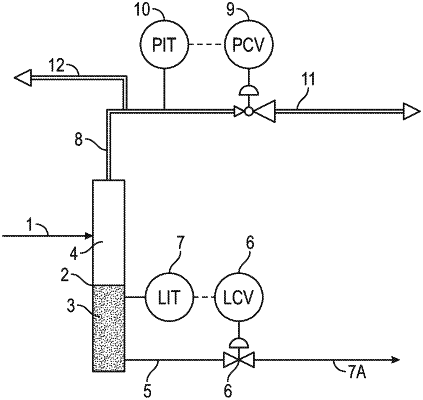| CPC C07C 303/44 (2013.01) [B01D 3/143 (2013.01); B01D 19/0005 (2013.01); B01D 19/0036 (2013.01); B01D 19/0063 (2013.01); B01D 19/0068 (2013.01); B01J 19/0006 (2013.01); B01J 19/2465 (2013.01); B01J 2219/00051 (2013.01); B01J 2219/00162 (2013.01)] | 10 Claims |

|
1. A method for recovering a distillable, anhydrous methane-sulfonic acid (MSA) liquid phase from an anhydrous 2-phase gas-liquid feed stream, said 2-phase gas-liquid feed stream having an initial pressure in a range of from 100 psi up to 2000 psi, and a temperature in the range of from 40° C. up to 90° C. wherein:
(i) the liquid phase of the gas-liquid feed stream comprises a mixture of MSA, dissolved methane, SO3, and, optionally, H2SO4, and
(ii) the gas phase of the gas-liquid feed stream comprises methane and SO3, said method comprising:
(A) separating the gas phase from the liquid phase by reducing the pressure of the gas and liquid phases to a value which is at least 2 up to 10 psi below the initial pressure in the 2-phase gas-liquid feed stream;
(B) passing the separated liquid phase into a stripping column while simultaneously passing a stripping gas into the stripping column in countercurrent flow to the separated liquid phase, wherein the flow rate of stripping gas is in the range of from 3 to 10 moles of stripping gas per liter of SO3 in the separated liquid phase, and the temperature of the stripping column is in the range of from ambient up to 160° C., with the result that the SO3 concentration in the separated liquid phase which exits the stripping column has been reduced to a value in the range of from 5 ppm to 1000 ppm without the addition of water or any other reactive agent.
|